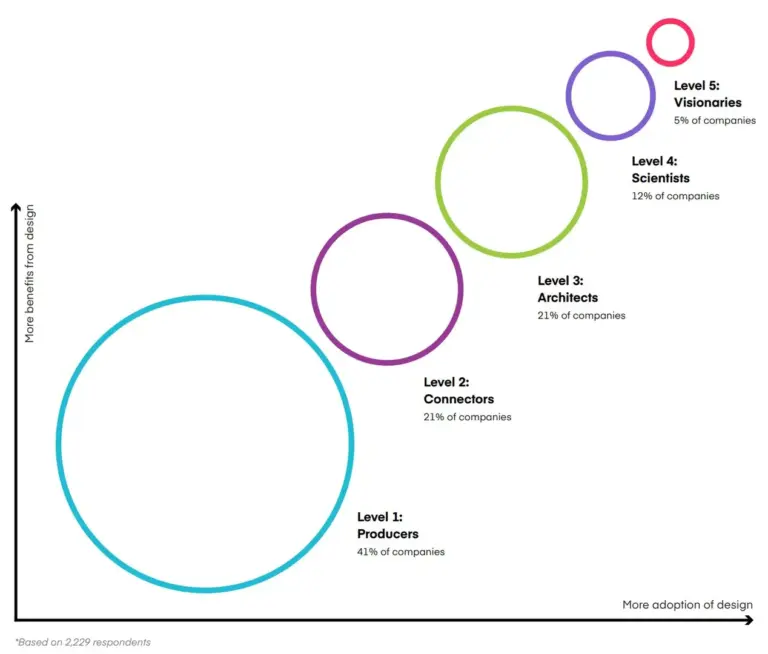Design influence doesn’t just happen. It emerges.
Reflections from the intersections of design on structure, strategy, and culture
When design as a function starts to evolve in a company, it either comes embedded from the beginning or enters later as a fresh perspective for change. In both cases, it doesn’t just influence output. It alters the way people collaborate, how decisions are made, and how business goals are approached. So what are the levels where design has this kind of impact? In the following, I explore different types of effects design and experience work can have from strategy to systems and from shaping conversations to enabling direction. Reflecting on my own experience, media that I consumed and people I spoke to.
Influence asymmetry: When execution isn’t enough
Design maturity and influence don’t automatically grow together. Execution can show value, but rarely reshapes the system that defines it. That’s the asymmetry: we expect execution to open doors to strategy, but without structural openness, the path ends where it began.
Some organizations recognize design as a lever early on, often because it was embedded from the start. In others, influence grows slowly, through trust and context. But it requires more than good work. It requires access. Most companies are not designed to be learning systems. They reward execution, not reflection. They fund certainty, not synthesis. And so, design is asked to act but not to ask. To deliver, but not to define.
»In most organizations, execution is rewarded over reflection. As one study notes, “companies tend to favour action rather than reflection.” That creates a system optimized for certainty—metrics, delivery, speed—not for hypothesis, synthesis, or iterative understanding. In those environments design is asked to deliver, but rarely to reflect.«
Inkermann, M. Gürtler and A. Seegrün (Design 2020 conference)
Even when design has a seat early on, timing still matters. Influence needs momentum, and momentum depends on more than structure. It depends on how teams learn and lead together. Like Dennis Hambeukers outlines (using Peter Senge »Five Disciplines of of a Learning Organization« approach), and like I’ve experienced myself you can’t skip steps, and progress is not always linear. You can’t force timing. You can’t work against a system that isn’t open to change. So what does it take? A culture where maturity doesn’t mean hierarchy but capacity, like
- Personal mastery—Do we keep growing, or just refining what we already know?
- Mental models—Can we name what shapes our thinking? And are we open to changing it?
- Shared vision—Do we align early or only when the pressure gets loud?
- Team learning—Are we just executing next steps or learning how we work together?
- Systems thinking—Do we see the pattern or just follow the process?
Without the combination of those capabilities, the conditions for strategic design don’t emerge. And without those conditions, even excellent work will remain tactical.
That’s the asymmetry: we expect good work to lead to influence, but influence requires a system that supports (iterative) learning. And if that system isn’t in place, design will always be valued for its execution and excluded from the decisions that shape it.
When doors open and design begins to multiply its effect
But what happens when the system opens up? Where does Design/Experience as Strategic Partner have an effect? Here are a few levels on where I experienced design can create an effect:
Strategic Lever
Design becomes a thinking partner, shaping not just what is built, but why. Design creates space to reflect, ask better questions, and connect ideas to direction. It doesn’t own the strategy but helps surface and shape it early, before execution begins.
For example, design can help leadership teams reframe quarterly goals by mapping them against actual user needs, not just internal KPIs.
Cross-Collaboration
Design connects, across silos, roles, and mental models. By framing shared challenges visually and conceptually, design invites different perspectives into one conversation. It translates complexity into moments of alignment, often where language fails.
This might look like using a service blueprint to align product, engineering, and support teams around one customer journey instead of competing backlogs.
Framing & Problem Definition
Design creates the space where the right problem can appear. Design doesn’t start with answers. It begins with synthesis. By holding ambiguity, connecting inputs, and making tensions visible, it sharpens the focus — not just of what to solve, but how to approach it.
This often happens when a discovery process results not in a feature backlog, but in a redefined problem statement that resets the team’s direction.
Participation & Co-Creation
Design lowers the barrier to join — and raises the quality of what emerges. By working visually, iteratively, and openly, design invites others to shape. It distributes ownership, aligns teams earlier, and strengthens commitment to shared outcomes.
For instance, using sketches in early meetings allows engineers and stakeholders to build on ideas before anything is locked in or polished.
Ambidextrous Execution
Design bridges future exploration and present delivery. Design operates in the now and the next. It balances the need to ship with the ability to rethink. It delivers outcomes while questioning assumptions, operates on all levels.
For instance, while one part of the team delivers a first version to meet roadmap goals, design prototypes a longer-term flow to test assumptions and keep future options open.
What remains
So where does that leave us? Design doesn’t need more proof. It needs the right conditions. It grows by showing up in strategy conversations, in system shifts, and in everyday decisions that shape how people work. When the context allows for it, design moves across levels. Quietly. Consistently, it connects. It aligns. It creates meaning.
And maybe that’s the real maturity: not just knowing how to design well, but knowing where and when to act so that design makes others more capable too.





